Enterprise Systems and Organizational Performance Report
VerifiedAdded on 2022/09/14
|12
|3396
|49
Report
AI Summary
This report provides an executive summary on enterprise systems, exploring their role in enhancing business productivity and performance. It delves into the benefits across various functions like supply chain management, finance, and customer satisfaction. The report emphasizes the importance of organizational change management, including employee training, for successful implementation. It discusses the principles driving enterprise system adoption, their contribution to organizational performance by streamlining processes, integrating data, and improving efficiency. The report also highlights the significance of IT infrastructure and the need for sustainability. Furthermore, it examines the importance of aligning organizational culture and communication with stakeholders during the adoption process. The report concludes by emphasizing the need for employee training and data security measures to fully leverage the benefits of enterprise systems.

Enterprise Systems
Executive Summary
Executive Summary
Paraphrase This Document
Need a fresh take? Get an instant paraphrase of this document with our AI Paraphraser
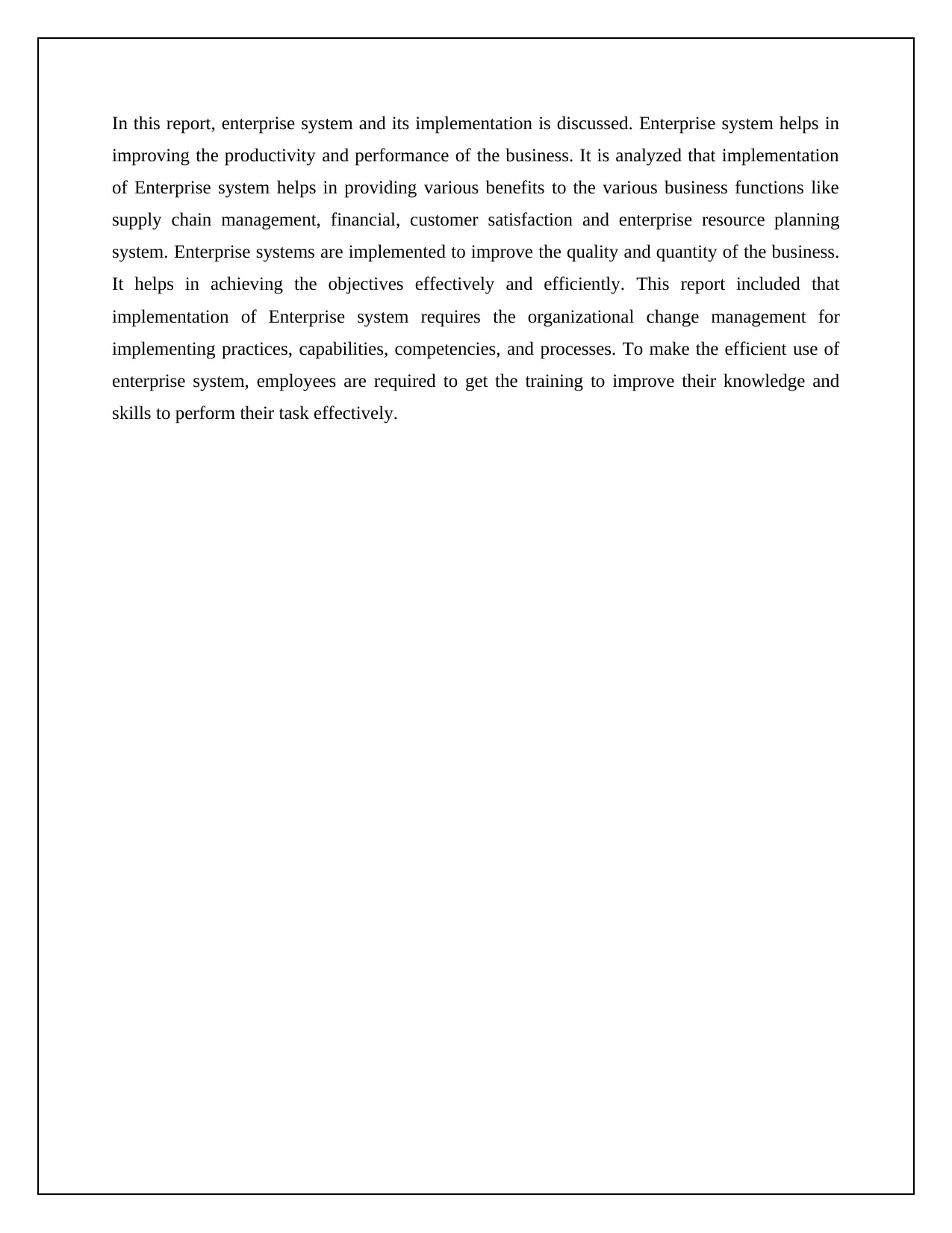
In this report, enterprise system and its implementation is discussed. Enterprise system helps in
improving the productivity and performance of the business. It is analyzed that implementation
of Enterprise system helps in providing various benefits to the various business functions like
supply chain management, financial, customer satisfaction and enterprise resource planning
system. Enterprise systems are implemented to improve the quality and quantity of the business.
It helps in achieving the objectives effectively and efficiently. This report included that
implementation of Enterprise system requires the organizational change management for
implementing practices, capabilities, competencies, and processes. To make the efficient use of
enterprise system, employees are required to get the training to improve their knowledge and
skills to perform their task effectively.
improving the productivity and performance of the business. It is analyzed that implementation
of Enterprise system helps in providing various benefits to the various business functions like
supply chain management, financial, customer satisfaction and enterprise resource planning
system. Enterprise systems are implemented to improve the quality and quantity of the business.
It helps in achieving the objectives effectively and efficiently. This report included that
implementation of Enterprise system requires the organizational change management for
implementing practices, capabilities, competencies, and processes. To make the efficient use of
enterprise system, employees are required to get the training to improve their knowledge and
skills to perform their task effectively.
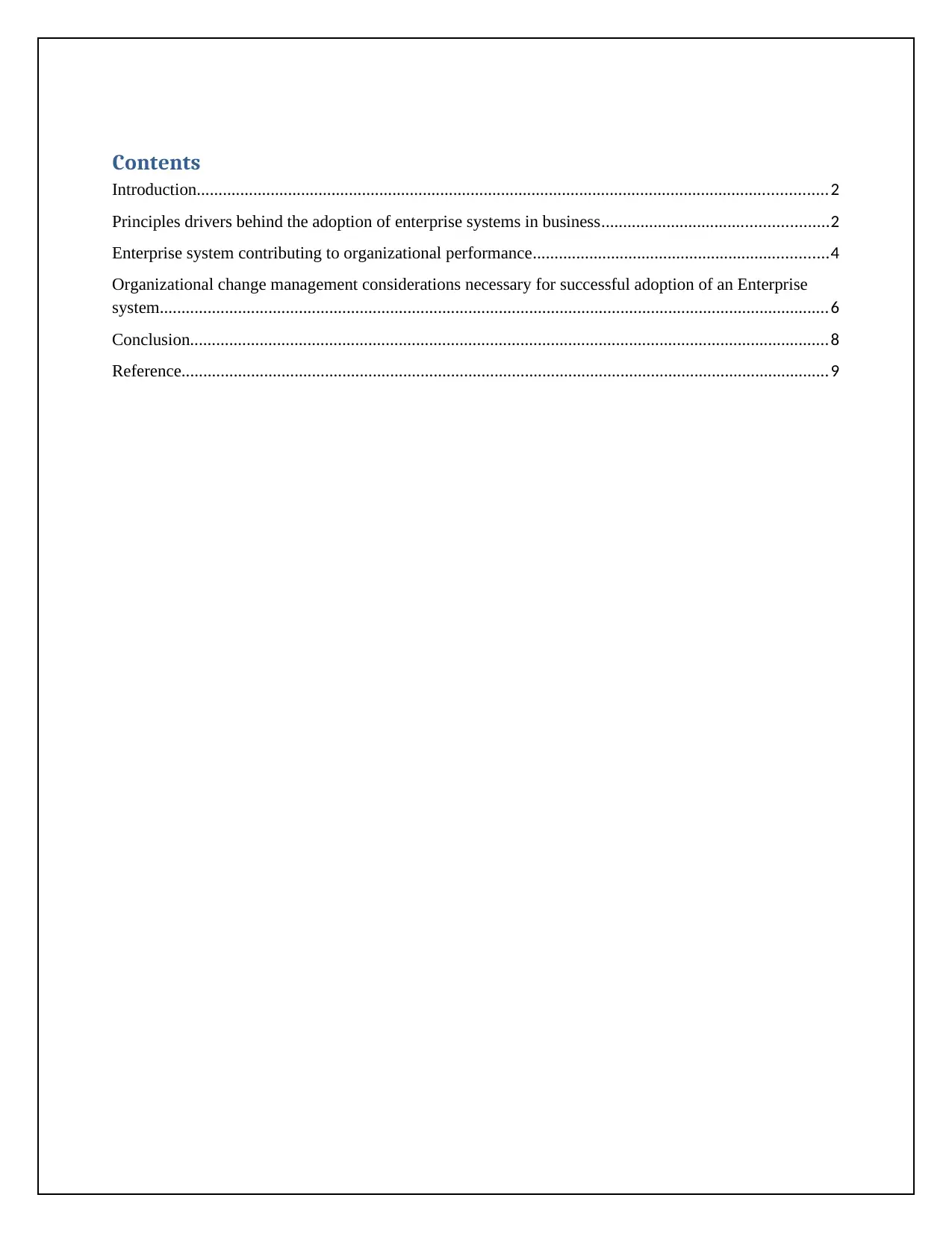
Contents
Introduction.................................................................................................................................................2
Principles drivers behind the adoption of enterprise systems in business....................................................2
Enterprise system contributing to organizational performance....................................................................4
Organizational change management considerations necessary for successful adoption of an Enterprise
system..........................................................................................................................................................6
Conclusion...................................................................................................................................................8
Reference.....................................................................................................................................................9
Introduction.................................................................................................................................................2
Principles drivers behind the adoption of enterprise systems in business....................................................2
Enterprise system contributing to organizational performance....................................................................4
Organizational change management considerations necessary for successful adoption of an Enterprise
system..........................................................................................................................................................6
Conclusion...................................................................................................................................................8
Reference.....................................................................................................................................................9
⊘ This is a preview!⊘
Do you want full access?
Subscribe today to unlock all pages.

Trusted by 1+ million students worldwide
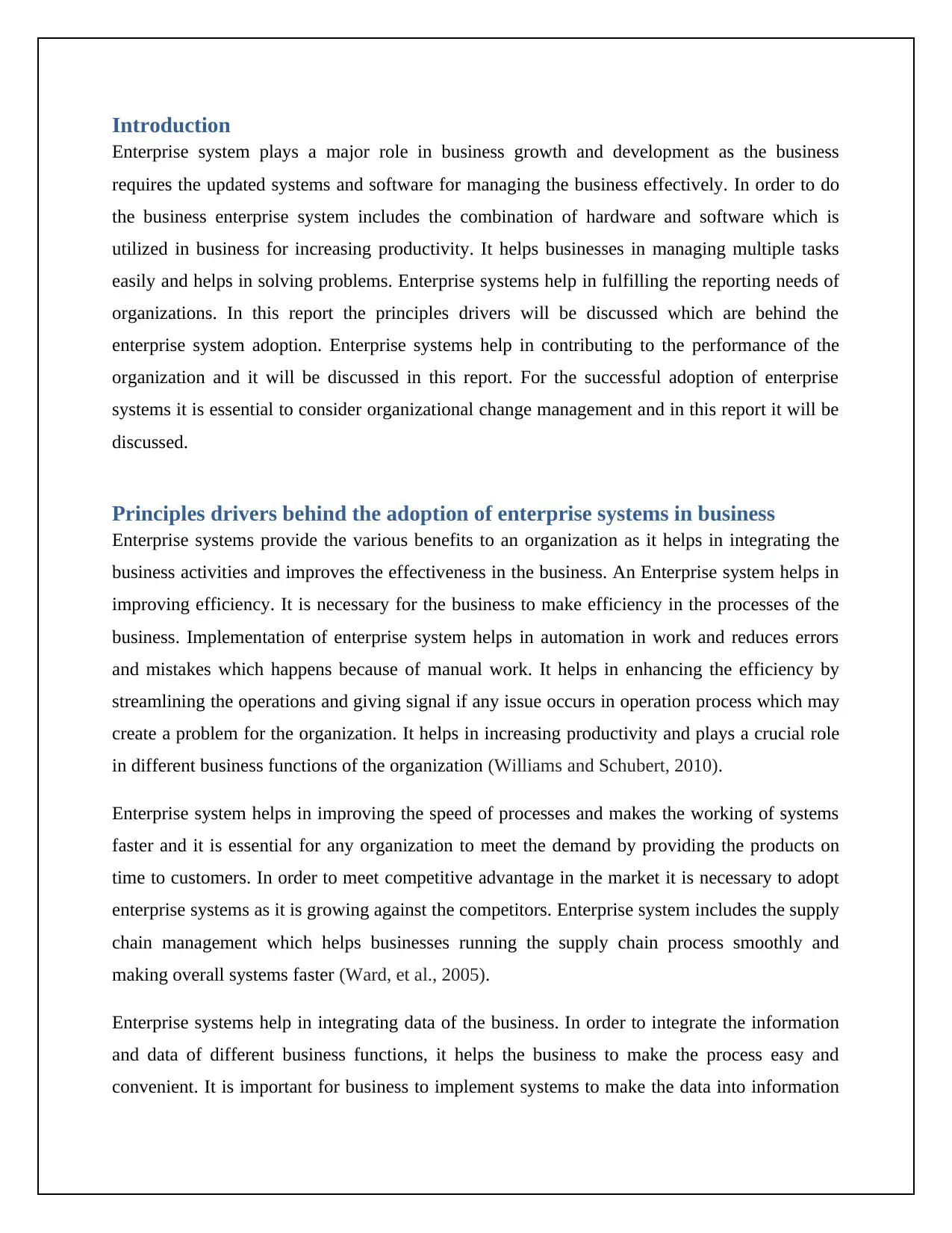
Introduction
Enterprise system plays a major role in business growth and development as the business
requires the updated systems and software for managing the business effectively. In order to do
the business enterprise system includes the combination of hardware and software which is
utilized in business for increasing productivity. It helps businesses in managing multiple tasks
easily and helps in solving problems. Enterprise systems help in fulfilling the reporting needs of
organizations. In this report the principles drivers will be discussed which are behind the
enterprise system adoption. Enterprise systems help in contributing to the performance of the
organization and it will be discussed in this report. For the successful adoption of enterprise
systems it is essential to consider organizational change management and in this report it will be
discussed.
Principles drivers behind the adoption of enterprise systems in business
Enterprise systems provide the various benefits to an organization as it helps in integrating the
business activities and improves the effectiveness in the business. An Enterprise system helps in
improving efficiency. It is necessary for the business to make efficiency in the processes of the
business. Implementation of enterprise system helps in automation in work and reduces errors
and mistakes which happens because of manual work. It helps in enhancing the efficiency by
streamlining the operations and giving signal if any issue occurs in operation process which may
create a problem for the organization. It helps in increasing productivity and plays a crucial role
in different business functions of the organization (Williams and Schubert, 2010).
Enterprise system helps in improving the speed of processes and makes the working of systems
faster and it is essential for any organization to meet the demand by providing the products on
time to customers. In order to meet competitive advantage in the market it is necessary to adopt
enterprise systems as it is growing against the competitors. Enterprise system includes the supply
chain management which helps businesses running the supply chain process smoothly and
making overall systems faster (Ward, et al., 2005).
Enterprise systems help in integrating data of the business. In order to integrate the information
and data of different business functions, it helps the business to make the process easy and
convenient. It is important for business to implement systems to make the data into information
Enterprise system plays a major role in business growth and development as the business
requires the updated systems and software for managing the business effectively. In order to do
the business enterprise system includes the combination of hardware and software which is
utilized in business for increasing productivity. It helps businesses in managing multiple tasks
easily and helps in solving problems. Enterprise systems help in fulfilling the reporting needs of
organizations. In this report the principles drivers will be discussed which are behind the
enterprise system adoption. Enterprise systems help in contributing to the performance of the
organization and it will be discussed in this report. For the successful adoption of enterprise
systems it is essential to consider organizational change management and in this report it will be
discussed.
Principles drivers behind the adoption of enterprise systems in business
Enterprise systems provide the various benefits to an organization as it helps in integrating the
business activities and improves the effectiveness in the business. An Enterprise system helps in
improving efficiency. It is necessary for the business to make efficiency in the processes of the
business. Implementation of enterprise system helps in automation in work and reduces errors
and mistakes which happens because of manual work. It helps in enhancing the efficiency by
streamlining the operations and giving signal if any issue occurs in operation process which may
create a problem for the organization. It helps in increasing productivity and plays a crucial role
in different business functions of the organization (Williams and Schubert, 2010).
Enterprise system helps in improving the speed of processes and makes the working of systems
faster and it is essential for any organization to meet the demand by providing the products on
time to customers. In order to meet competitive advantage in the market it is necessary to adopt
enterprise systems as it is growing against the competitors. Enterprise system includes the supply
chain management which helps businesses running the supply chain process smoothly and
making overall systems faster (Ward, et al., 2005).
Enterprise systems help in integrating data of the business. In order to integrate the information
and data of different business functions, it helps the business to make the process easy and
convenient. It is important for business to implement systems to make the data into information
Paraphrase This Document
Need a fresh take? Get an instant paraphrase of this document with our AI Paraphraser
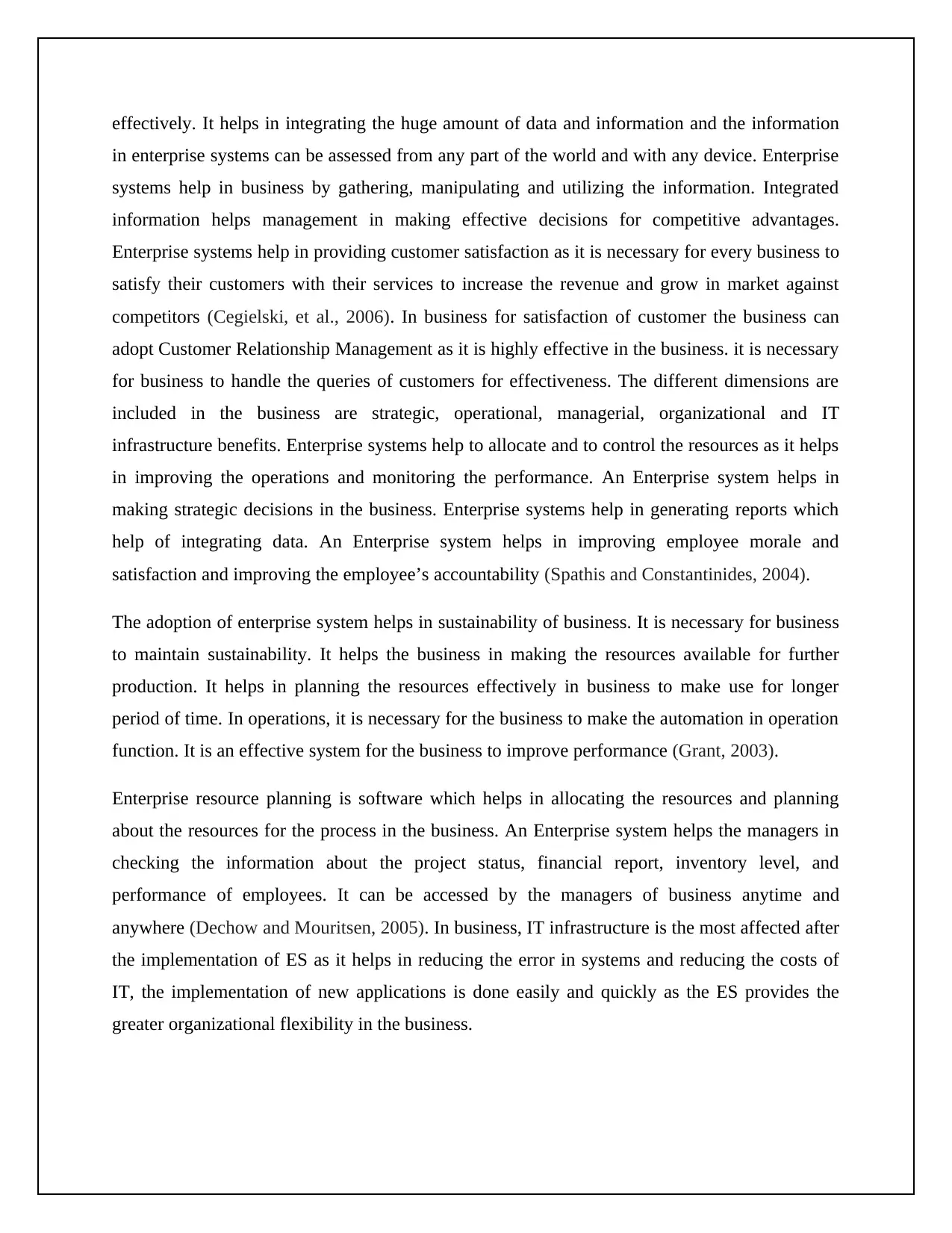
effectively. It helps in integrating the huge amount of data and information and the information
in enterprise systems can be assessed from any part of the world and with any device. Enterprise
systems help in business by gathering, manipulating and utilizing the information. Integrated
information helps management in making effective decisions for competitive advantages.
Enterprise systems help in providing customer satisfaction as it is necessary for every business to
satisfy their customers with their services to increase the revenue and grow in market against
competitors (Cegielski, et al., 2006). In business for satisfaction of customer the business can
adopt Customer Relationship Management as it is highly effective in the business. it is necessary
for business to handle the queries of customers for effectiveness. The different dimensions are
included in the business are strategic, operational, managerial, organizational and IT
infrastructure benefits. Enterprise systems help to allocate and to control the resources as it helps
in improving the operations and monitoring the performance. An Enterprise system helps in
making strategic decisions in the business. Enterprise systems help in generating reports which
help of integrating data. An Enterprise system helps in improving employee morale and
satisfaction and improving the employee’s accountability (Spathis and Constantinides, 2004).
The adoption of enterprise system helps in sustainability of business. It is necessary for business
to maintain sustainability. It helps the business in making the resources available for further
production. It helps in planning the resources effectively in business to make use for longer
period of time. In operations, it is necessary for the business to make the automation in operation
function. It is an effective system for the business to improve performance (Grant, 2003).
Enterprise resource planning is software which helps in allocating the resources and planning
about the resources for the process in the business. An Enterprise system helps the managers in
checking the information about the project status, financial report, inventory level, and
performance of employees. It can be accessed by the managers of business anytime and
anywhere (Dechow and Mouritsen, 2005). In business, IT infrastructure is the most affected after
the implementation of ES as it helps in reducing the error in systems and reducing the costs of
IT, the implementation of new applications is done easily and quickly as the ES provides the
greater organizational flexibility in the business.
in enterprise systems can be assessed from any part of the world and with any device. Enterprise
systems help in business by gathering, manipulating and utilizing the information. Integrated
information helps management in making effective decisions for competitive advantages.
Enterprise systems help in providing customer satisfaction as it is necessary for every business to
satisfy their customers with their services to increase the revenue and grow in market against
competitors (Cegielski, et al., 2006). In business for satisfaction of customer the business can
adopt Customer Relationship Management as it is highly effective in the business. it is necessary
for business to handle the queries of customers for effectiveness. The different dimensions are
included in the business are strategic, operational, managerial, organizational and IT
infrastructure benefits. Enterprise systems help to allocate and to control the resources as it helps
in improving the operations and monitoring the performance. An Enterprise system helps in
making strategic decisions in the business. Enterprise systems help in generating reports which
help of integrating data. An Enterprise system helps in improving employee morale and
satisfaction and improving the employee’s accountability (Spathis and Constantinides, 2004).
The adoption of enterprise system helps in sustainability of business. It is necessary for business
to maintain sustainability. It helps the business in making the resources available for further
production. It helps in planning the resources effectively in business to make use for longer
period of time. In operations, it is necessary for the business to make the automation in operation
function. It is an effective system for the business to improve performance (Grant, 2003).
Enterprise resource planning is software which helps in allocating the resources and planning
about the resources for the process in the business. An Enterprise system helps the managers in
checking the information about the project status, financial report, inventory level, and
performance of employees. It can be accessed by the managers of business anytime and
anywhere (Dechow and Mouritsen, 2005). In business, IT infrastructure is the most affected after
the implementation of ES as it helps in reducing the error in systems and reducing the costs of
IT, the implementation of new applications is done easily and quickly as the ES provides the
greater organizational flexibility in the business.
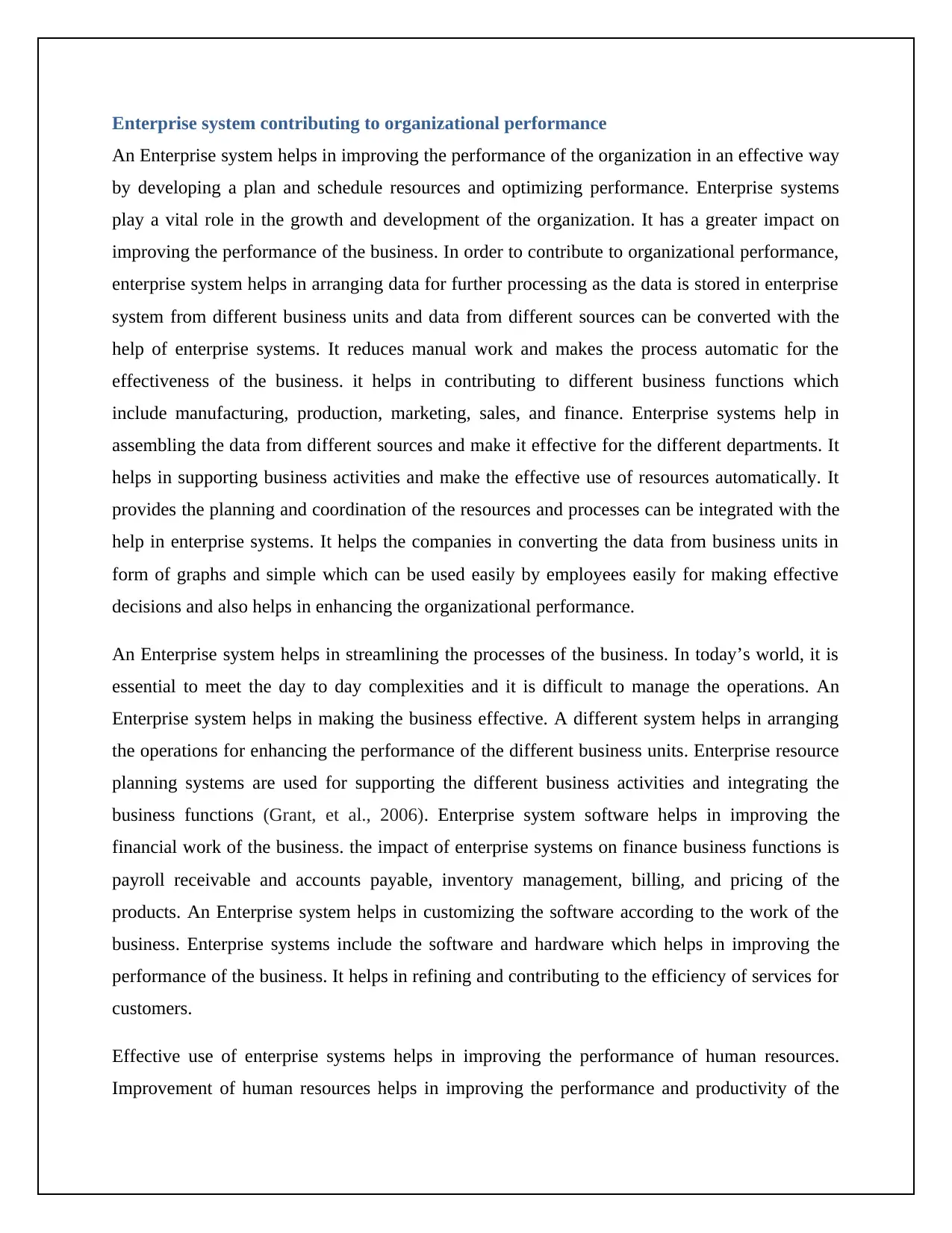
Enterprise system contributing to organizational performance
An Enterprise system helps in improving the performance of the organization in an effective way
by developing a plan and schedule resources and optimizing performance. Enterprise systems
play a vital role in the growth and development of the organization. It has a greater impact on
improving the performance of the business. In order to contribute to organizational performance,
enterprise system helps in arranging data for further processing as the data is stored in enterprise
system from different business units and data from different sources can be converted with the
help of enterprise systems. It reduces manual work and makes the process automatic for the
effectiveness of the business. it helps in contributing to different business functions which
include manufacturing, production, marketing, sales, and finance. Enterprise systems help in
assembling the data from different sources and make it effective for the different departments. It
helps in supporting business activities and make the effective use of resources automatically. It
provides the planning and coordination of the resources and processes can be integrated with the
help in enterprise systems. It helps the companies in converting the data from business units in
form of graphs and simple which can be used easily by employees easily for making effective
decisions and also helps in enhancing the organizational performance.
An Enterprise system helps in streamlining the processes of the business. In today’s world, it is
essential to meet the day to day complexities and it is difficult to manage the operations. An
Enterprise system helps in making the business effective. A different system helps in arranging
the operations for enhancing the performance of the different business units. Enterprise resource
planning systems are used for supporting the different business activities and integrating the
business functions (Grant, et al., 2006). Enterprise system software helps in improving the
financial work of the business. the impact of enterprise systems on finance business functions is
payroll receivable and accounts payable, inventory management, billing, and pricing of the
products. An Enterprise system helps in customizing the software according to the work of the
business. Enterprise systems include the software and hardware which helps in improving the
performance of the business. It helps in refining and contributing to the efficiency of services for
customers.
Effective use of enterprise systems helps in improving the performance of human resources.
Improvement of human resources helps in improving the performance and productivity of the
An Enterprise system helps in improving the performance of the organization in an effective way
by developing a plan and schedule resources and optimizing performance. Enterprise systems
play a vital role in the growth and development of the organization. It has a greater impact on
improving the performance of the business. In order to contribute to organizational performance,
enterprise system helps in arranging data for further processing as the data is stored in enterprise
system from different business units and data from different sources can be converted with the
help of enterprise systems. It reduces manual work and makes the process automatic for the
effectiveness of the business. it helps in contributing to different business functions which
include manufacturing, production, marketing, sales, and finance. Enterprise systems help in
assembling the data from different sources and make it effective for the different departments. It
helps in supporting business activities and make the effective use of resources automatically. It
provides the planning and coordination of the resources and processes can be integrated with the
help in enterprise systems. It helps the companies in converting the data from business units in
form of graphs and simple which can be used easily by employees easily for making effective
decisions and also helps in enhancing the organizational performance.
An Enterprise system helps in streamlining the processes of the business. In today’s world, it is
essential to meet the day to day complexities and it is difficult to manage the operations. An
Enterprise system helps in making the business effective. A different system helps in arranging
the operations for enhancing the performance of the different business units. Enterprise resource
planning systems are used for supporting the different business activities and integrating the
business functions (Grant, et al., 2006). Enterprise system software helps in improving the
financial work of the business. the impact of enterprise systems on finance business functions is
payroll receivable and accounts payable, inventory management, billing, and pricing of the
products. An Enterprise system helps in customizing the software according to the work of the
business. Enterprise systems include the software and hardware which helps in improving the
performance of the business. It helps in refining and contributing to the efficiency of services for
customers.
Effective use of enterprise systems helps in improving the performance of human resources.
Improvement of human resources helps in improving the performance and productivity of the
⊘ This is a preview!⊘
Do you want full access?
Subscribe today to unlock all pages.

Trusted by 1+ million students worldwide
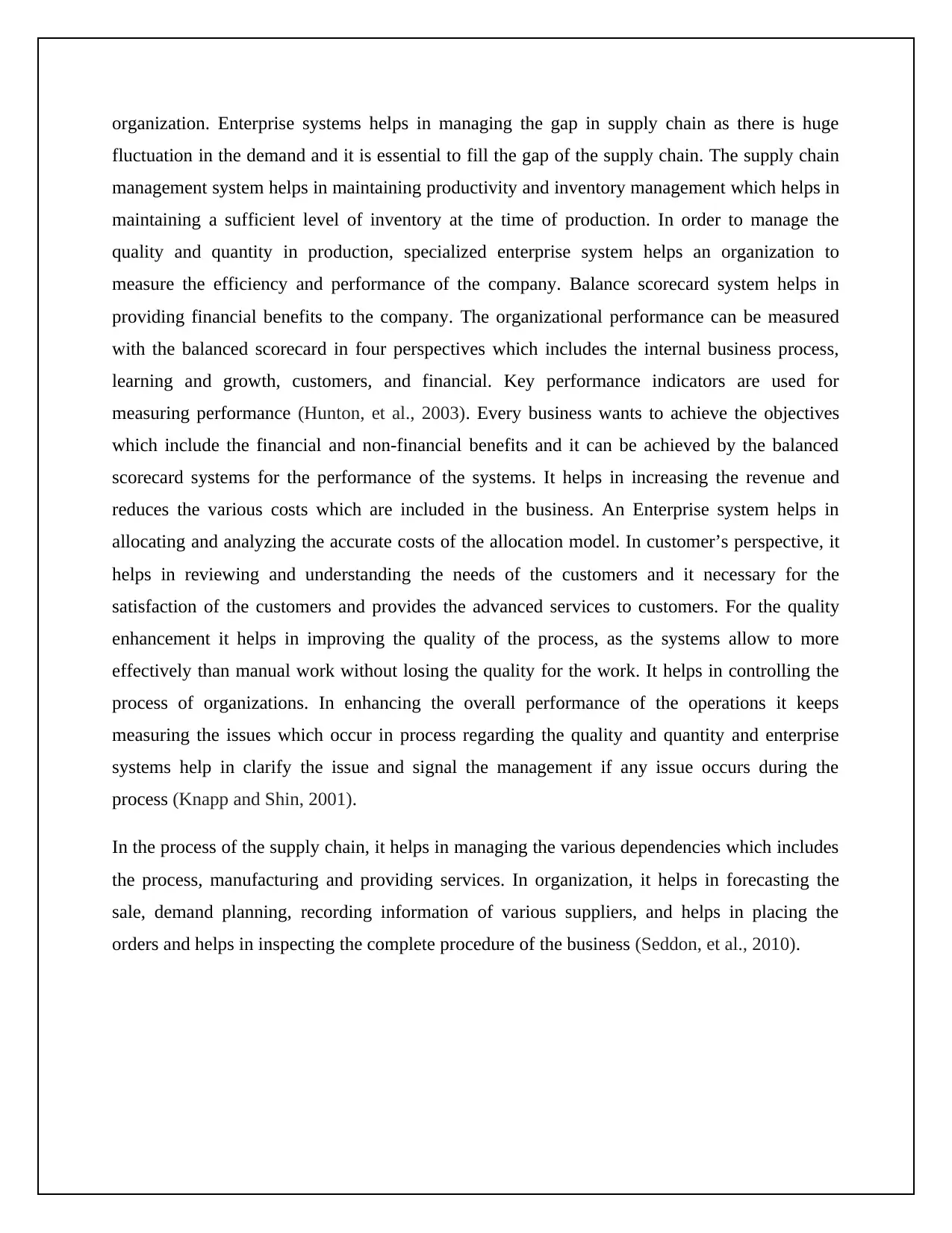
organization. Enterprise systems helps in managing the gap in supply chain as there is huge
fluctuation in the demand and it is essential to fill the gap of the supply chain. The supply chain
management system helps in maintaining productivity and inventory management which helps in
maintaining a sufficient level of inventory at the time of production. In order to manage the
quality and quantity in production, specialized enterprise system helps an organization to
measure the efficiency and performance of the company. Balance scorecard system helps in
providing financial benefits to the company. The organizational performance can be measured
with the balanced scorecard in four perspectives which includes the internal business process,
learning and growth, customers, and financial. Key performance indicators are used for
measuring performance (Hunton, et al., 2003). Every business wants to achieve the objectives
which include the financial and non-financial benefits and it can be achieved by the balanced
scorecard systems for the performance of the systems. It helps in increasing the revenue and
reduces the various costs which are included in the business. An Enterprise system helps in
allocating and analyzing the accurate costs of the allocation model. In customer’s perspective, it
helps in reviewing and understanding the needs of the customers and it necessary for the
satisfaction of the customers and provides the advanced services to customers. For the quality
enhancement it helps in improving the quality of the process, as the systems allow to more
effectively than manual work without losing the quality for the work. It helps in controlling the
process of organizations. In enhancing the overall performance of the operations it keeps
measuring the issues which occur in process regarding the quality and quantity and enterprise
systems help in clarify the issue and signal the management if any issue occurs during the
process (Knapp and Shin, 2001).
In the process of the supply chain, it helps in managing the various dependencies which includes
the process, manufacturing and providing services. In organization, it helps in forecasting the
sale, demand planning, recording information of various suppliers, and helps in placing the
orders and helps in inspecting the complete procedure of the business (Seddon, et al., 2010).
fluctuation in the demand and it is essential to fill the gap of the supply chain. The supply chain
management system helps in maintaining productivity and inventory management which helps in
maintaining a sufficient level of inventory at the time of production. In order to manage the
quality and quantity in production, specialized enterprise system helps an organization to
measure the efficiency and performance of the company. Balance scorecard system helps in
providing financial benefits to the company. The organizational performance can be measured
with the balanced scorecard in four perspectives which includes the internal business process,
learning and growth, customers, and financial. Key performance indicators are used for
measuring performance (Hunton, et al., 2003). Every business wants to achieve the objectives
which include the financial and non-financial benefits and it can be achieved by the balanced
scorecard systems for the performance of the systems. It helps in increasing the revenue and
reduces the various costs which are included in the business. An Enterprise system helps in
allocating and analyzing the accurate costs of the allocation model. In customer’s perspective, it
helps in reviewing and understanding the needs of the customers and it necessary for the
satisfaction of the customers and provides the advanced services to customers. For the quality
enhancement it helps in improving the quality of the process, as the systems allow to more
effectively than manual work without losing the quality for the work. It helps in controlling the
process of organizations. In enhancing the overall performance of the operations it keeps
measuring the issues which occur in process regarding the quality and quantity and enterprise
systems help in clarify the issue and signal the management if any issue occurs during the
process (Knapp and Shin, 2001).
In the process of the supply chain, it helps in managing the various dependencies which includes
the process, manufacturing and providing services. In organization, it helps in forecasting the
sale, demand planning, recording information of various suppliers, and helps in placing the
orders and helps in inspecting the complete procedure of the business (Seddon, et al., 2010).
Paraphrase This Document
Need a fresh take? Get an instant paraphrase of this document with our AI Paraphraser
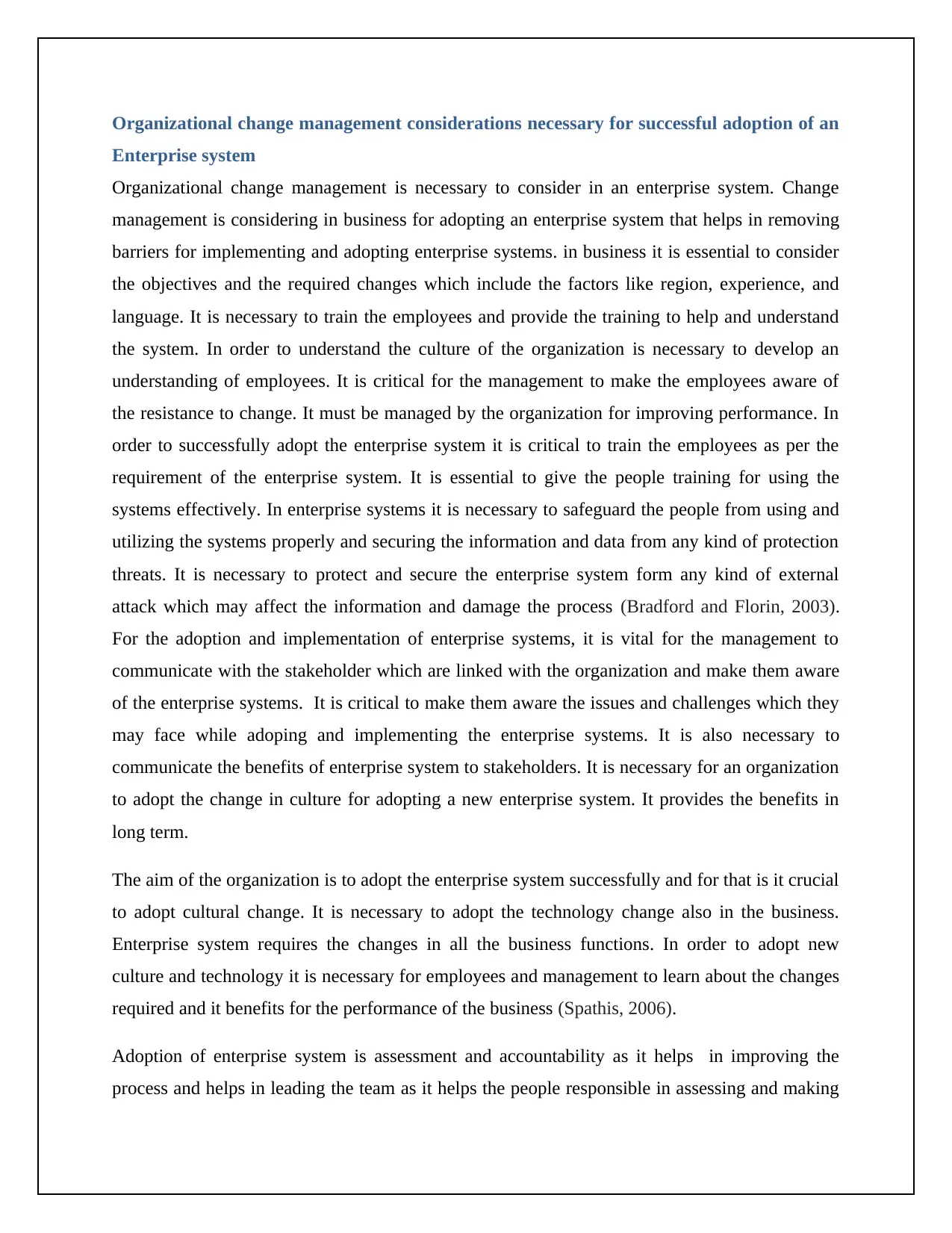
Organizational change management considerations necessary for successful adoption of an
Enterprise system
Organizational change management is necessary to consider in an enterprise system. Change
management is considering in business for adopting an enterprise system that helps in removing
barriers for implementing and adopting enterprise systems. in business it is essential to consider
the objectives and the required changes which include the factors like region, experience, and
language. It is necessary to train the employees and provide the training to help and understand
the system. In order to understand the culture of the organization is necessary to develop an
understanding of employees. It is critical for the management to make the employees aware of
the resistance to change. It must be managed by the organization for improving performance. In
order to successfully adopt the enterprise system it is critical to train the employees as per the
requirement of the enterprise system. It is essential to give the people training for using the
systems effectively. In enterprise systems it is necessary to safeguard the people from using and
utilizing the systems properly and securing the information and data from any kind of protection
threats. It is necessary to protect and secure the enterprise system form any kind of external
attack which may affect the information and damage the process (Bradford and Florin, 2003).
For the adoption and implementation of enterprise systems, it is vital for the management to
communicate with the stakeholder which are linked with the organization and make them aware
of the enterprise systems. It is critical to make them aware the issues and challenges which they
may face while adoping and implementing the enterprise systems. It is also necessary to
communicate the benefits of enterprise system to stakeholders. It is necessary for an organization
to adopt the change in culture for adopting a new enterprise system. It provides the benefits in
long term.
The aim of the organization is to adopt the enterprise system successfully and for that is it crucial
to adopt cultural change. It is necessary to adopt the technology change also in the business.
Enterprise system requires the changes in all the business functions. In order to adopt new
culture and technology it is necessary for employees and management to learn about the changes
required and it benefits for the performance of the business (Spathis, 2006).
Adoption of enterprise system is assessment and accountability as it helps in improving the
process and helps in leading the team as it helps the people responsible in assessing and making
Enterprise system
Organizational change management is necessary to consider in an enterprise system. Change
management is considering in business for adopting an enterprise system that helps in removing
barriers for implementing and adopting enterprise systems. in business it is essential to consider
the objectives and the required changes which include the factors like region, experience, and
language. It is necessary to train the employees and provide the training to help and understand
the system. In order to understand the culture of the organization is necessary to develop an
understanding of employees. It is critical for the management to make the employees aware of
the resistance to change. It must be managed by the organization for improving performance. In
order to successfully adopt the enterprise system it is critical to train the employees as per the
requirement of the enterprise system. It is essential to give the people training for using the
systems effectively. In enterprise systems it is necessary to safeguard the people from using and
utilizing the systems properly and securing the information and data from any kind of protection
threats. It is necessary to protect and secure the enterprise system form any kind of external
attack which may affect the information and damage the process (Bradford and Florin, 2003).
For the adoption and implementation of enterprise systems, it is vital for the management to
communicate with the stakeholder which are linked with the organization and make them aware
of the enterprise systems. It is critical to make them aware the issues and challenges which they
may face while adoping and implementing the enterprise systems. It is also necessary to
communicate the benefits of enterprise system to stakeholders. It is necessary for an organization
to adopt the change in culture for adopting a new enterprise system. It provides the benefits in
long term.
The aim of the organization is to adopt the enterprise system successfully and for that is it crucial
to adopt cultural change. It is necessary to adopt the technology change also in the business.
Enterprise system requires the changes in all the business functions. In order to adopt new
culture and technology it is necessary for employees and management to learn about the changes
required and it benefits for the performance of the business (Spathis, 2006).
Adoption of enterprise system is assessment and accountability as it helps in improving the
process and helps in leading the team as it helps the people responsible in assessing and making
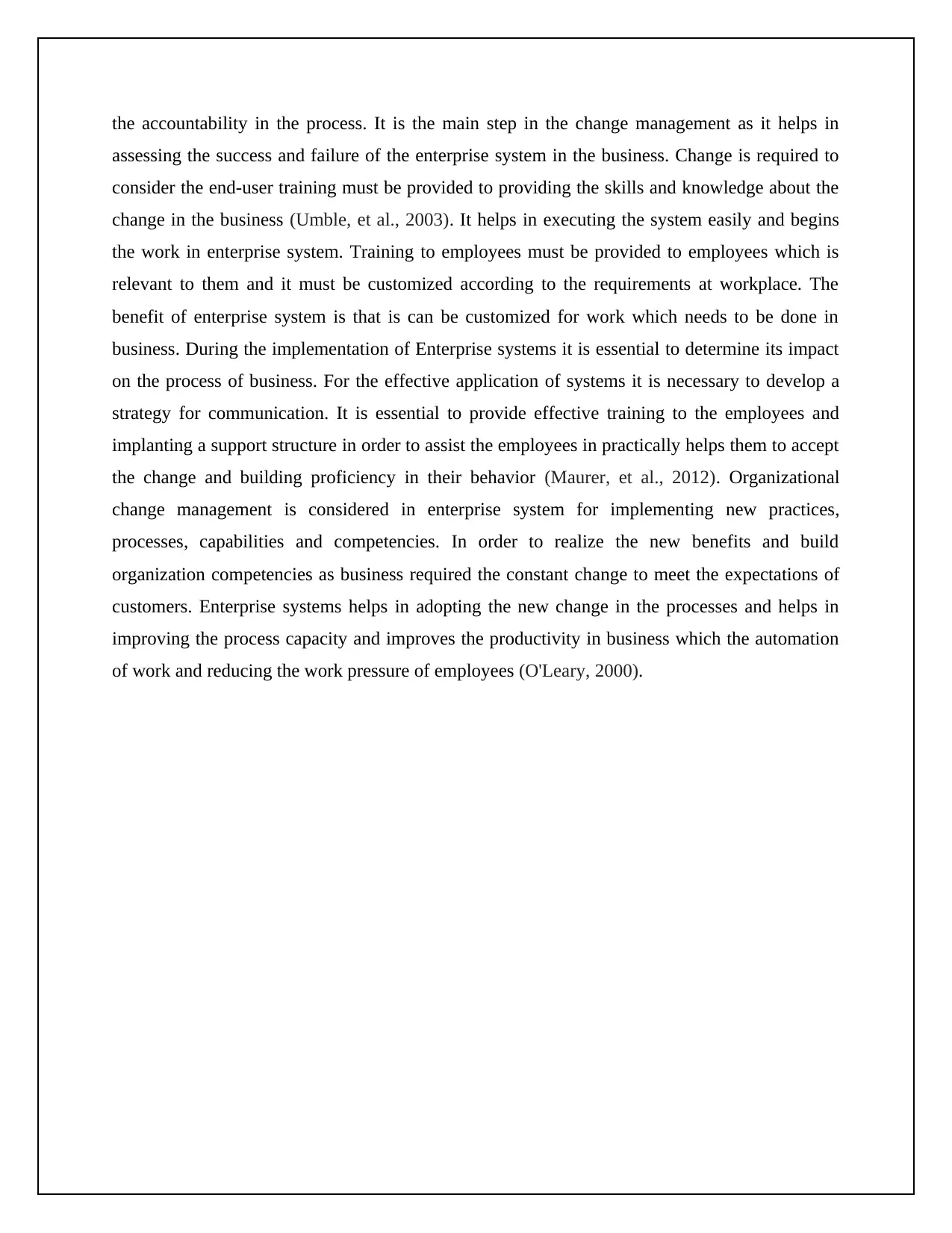
the accountability in the process. It is the main step in the change management as it helps in
assessing the success and failure of the enterprise system in the business. Change is required to
consider the end-user training must be provided to providing the skills and knowledge about the
change in the business (Umble, et al., 2003). It helps in executing the system easily and begins
the work in enterprise system. Training to employees must be provided to employees which is
relevant to them and it must be customized according to the requirements at workplace. The
benefit of enterprise system is that is can be customized for work which needs to be done in
business. During the implementation of Enterprise systems it is essential to determine its impact
on the process of business. For the effective application of systems it is necessary to develop a
strategy for communication. It is essential to provide effective training to the employees and
implanting a support structure in order to assist the employees in practically helps them to accept
the change and building proficiency in their behavior (Maurer, et al., 2012). Organizational
change management is considered in enterprise system for implementing new practices,
processes, capabilities and competencies. In order to realize the new benefits and build
organization competencies as business required the constant change to meet the expectations of
customers. Enterprise systems helps in adopting the new change in the processes and helps in
improving the process capacity and improves the productivity in business which the automation
of work and reducing the work pressure of employees (O'Leary, 2000).
assessing the success and failure of the enterprise system in the business. Change is required to
consider the end-user training must be provided to providing the skills and knowledge about the
change in the business (Umble, et al., 2003). It helps in executing the system easily and begins
the work in enterprise system. Training to employees must be provided to employees which is
relevant to them and it must be customized according to the requirements at workplace. The
benefit of enterprise system is that is can be customized for work which needs to be done in
business. During the implementation of Enterprise systems it is essential to determine its impact
on the process of business. For the effective application of systems it is necessary to develop a
strategy for communication. It is essential to provide effective training to the employees and
implanting a support structure in order to assist the employees in practically helps them to accept
the change and building proficiency in their behavior (Maurer, et al., 2012). Organizational
change management is considered in enterprise system for implementing new practices,
processes, capabilities and competencies. In order to realize the new benefits and build
organization competencies as business required the constant change to meet the expectations of
customers. Enterprise systems helps in adopting the new change in the processes and helps in
improving the process capacity and improves the productivity in business which the automation
of work and reducing the work pressure of employees (O'Leary, 2000).
⊘ This is a preview!⊘
Do you want full access?
Subscribe today to unlock all pages.

Trusted by 1+ million students worldwide
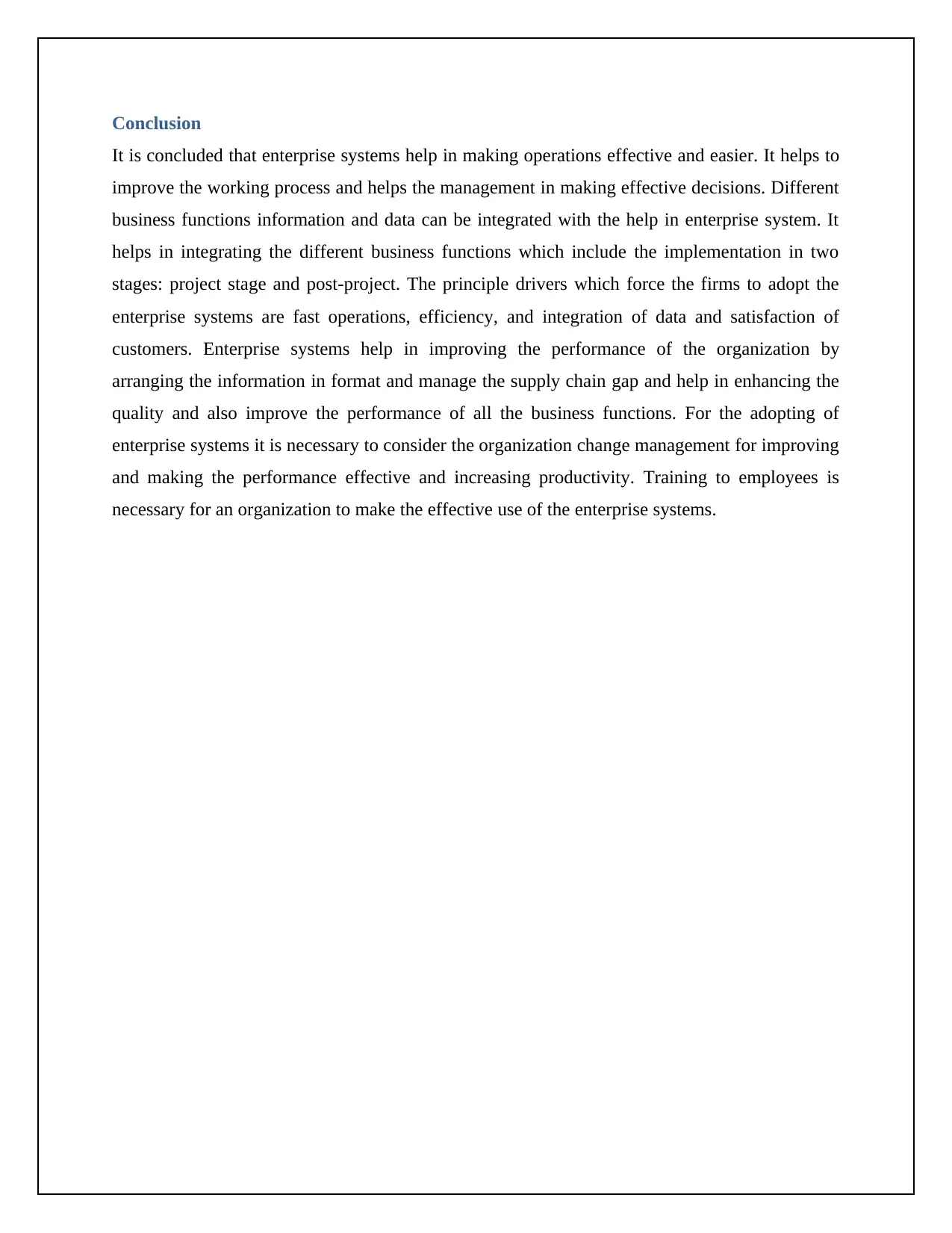
Conclusion
It is concluded that enterprise systems help in making operations effective and easier. It helps to
improve the working process and helps the management in making effective decisions. Different
business functions information and data can be integrated with the help in enterprise system. It
helps in integrating the different business functions which include the implementation in two
stages: project stage and post-project. The principle drivers which force the firms to adopt the
enterprise systems are fast operations, efficiency, and integration of data and satisfaction of
customers. Enterprise systems help in improving the performance of the organization by
arranging the information in format and manage the supply chain gap and help in enhancing the
quality and also improve the performance of all the business functions. For the adopting of
enterprise systems it is necessary to consider the organization change management for improving
and making the performance effective and increasing productivity. Training to employees is
necessary for an organization to make the effective use of the enterprise systems.
It is concluded that enterprise systems help in making operations effective and easier. It helps to
improve the working process and helps the management in making effective decisions. Different
business functions information and data can be integrated with the help in enterprise system. It
helps in integrating the different business functions which include the implementation in two
stages: project stage and post-project. The principle drivers which force the firms to adopt the
enterprise systems are fast operations, efficiency, and integration of data and satisfaction of
customers. Enterprise systems help in improving the performance of the organization by
arranging the information in format and manage the supply chain gap and help in enhancing the
quality and also improve the performance of all the business functions. For the adopting of
enterprise systems it is necessary to consider the organization change management for improving
and making the performance effective and increasing productivity. Training to employees is
necessary for an organization to make the effective use of the enterprise systems.
Paraphrase This Document
Need a fresh take? Get an instant paraphrase of this document with our AI Paraphraser
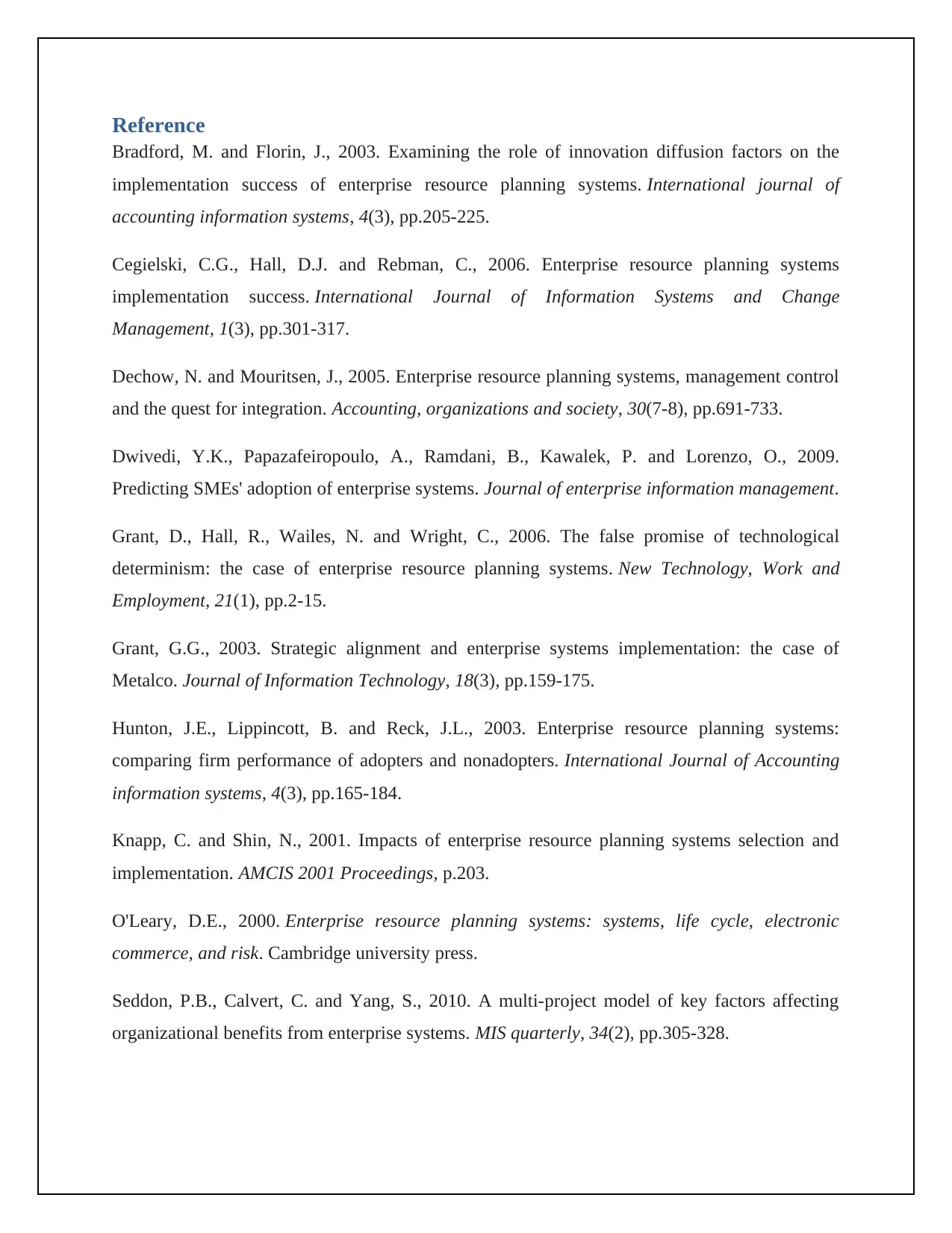
Reference
Bradford, M. and Florin, J., 2003. Examining the role of innovation diffusion factors on the
implementation success of enterprise resource planning systems. International journal of
accounting information systems, 4(3), pp.205-225.
Cegielski, C.G., Hall, D.J. and Rebman, C., 2006. Enterprise resource planning systems
implementation success. International Journal of Information Systems and Change
Management, 1(3), pp.301-317.
Dechow, N. and Mouritsen, J., 2005. Enterprise resource planning systems, management control
and the quest for integration. Accounting, organizations and society, 30(7-8), pp.691-733.
Dwivedi, Y.K., Papazafeiropoulo, A., Ramdani, B., Kawalek, P. and Lorenzo, O., 2009.
Predicting SMEs' adoption of enterprise systems. Journal of enterprise information management.
Grant, D., Hall, R., Wailes, N. and Wright, C., 2006. The false promise of technological
determinism: the case of enterprise resource planning systems. New Technology, Work and
Employment, 21(1), pp.2-15.
Grant, G.G., 2003. Strategic alignment and enterprise systems implementation: the case of
Metalco. Journal of Information Technology, 18(3), pp.159-175.
Hunton, J.E., Lippincott, B. and Reck, J.L., 2003. Enterprise resource planning systems:
comparing firm performance of adopters and nonadopters. International Journal of Accounting
information systems, 4(3), pp.165-184.
Knapp, C. and Shin, N., 2001. Impacts of enterprise resource planning systems selection and
implementation. AMCIS 2001 Proceedings, p.203.
O'Leary, D.E., 2000. Enterprise resource planning systems: systems, life cycle, electronic
commerce, and risk. Cambridge university press.
Seddon, P.B., Calvert, C. and Yang, S., 2010. A multi-project model of key factors affecting
organizational benefits from enterprise systems. MIS quarterly, 34(2), pp.305-328.
Bradford, M. and Florin, J., 2003. Examining the role of innovation diffusion factors on the
implementation success of enterprise resource planning systems. International journal of
accounting information systems, 4(3), pp.205-225.
Cegielski, C.G., Hall, D.J. and Rebman, C., 2006. Enterprise resource planning systems
implementation success. International Journal of Information Systems and Change
Management, 1(3), pp.301-317.
Dechow, N. and Mouritsen, J., 2005. Enterprise resource planning systems, management control
and the quest for integration. Accounting, organizations and society, 30(7-8), pp.691-733.
Dwivedi, Y.K., Papazafeiropoulo, A., Ramdani, B., Kawalek, P. and Lorenzo, O., 2009.
Predicting SMEs' adoption of enterprise systems. Journal of enterprise information management.
Grant, D., Hall, R., Wailes, N. and Wright, C., 2006. The false promise of technological
determinism: the case of enterprise resource planning systems. New Technology, Work and
Employment, 21(1), pp.2-15.
Grant, G.G., 2003. Strategic alignment and enterprise systems implementation: the case of
Metalco. Journal of Information Technology, 18(3), pp.159-175.
Hunton, J.E., Lippincott, B. and Reck, J.L., 2003. Enterprise resource planning systems:
comparing firm performance of adopters and nonadopters. International Journal of Accounting
information systems, 4(3), pp.165-184.
Knapp, C. and Shin, N., 2001. Impacts of enterprise resource planning systems selection and
implementation. AMCIS 2001 Proceedings, p.203.
O'Leary, D.E., 2000. Enterprise resource planning systems: systems, life cycle, electronic
commerce, and risk. Cambridge university press.
Seddon, P.B., Calvert, C. and Yang, S., 2010. A multi-project model of key factors affecting
organizational benefits from enterprise systems. MIS quarterly, 34(2), pp.305-328.
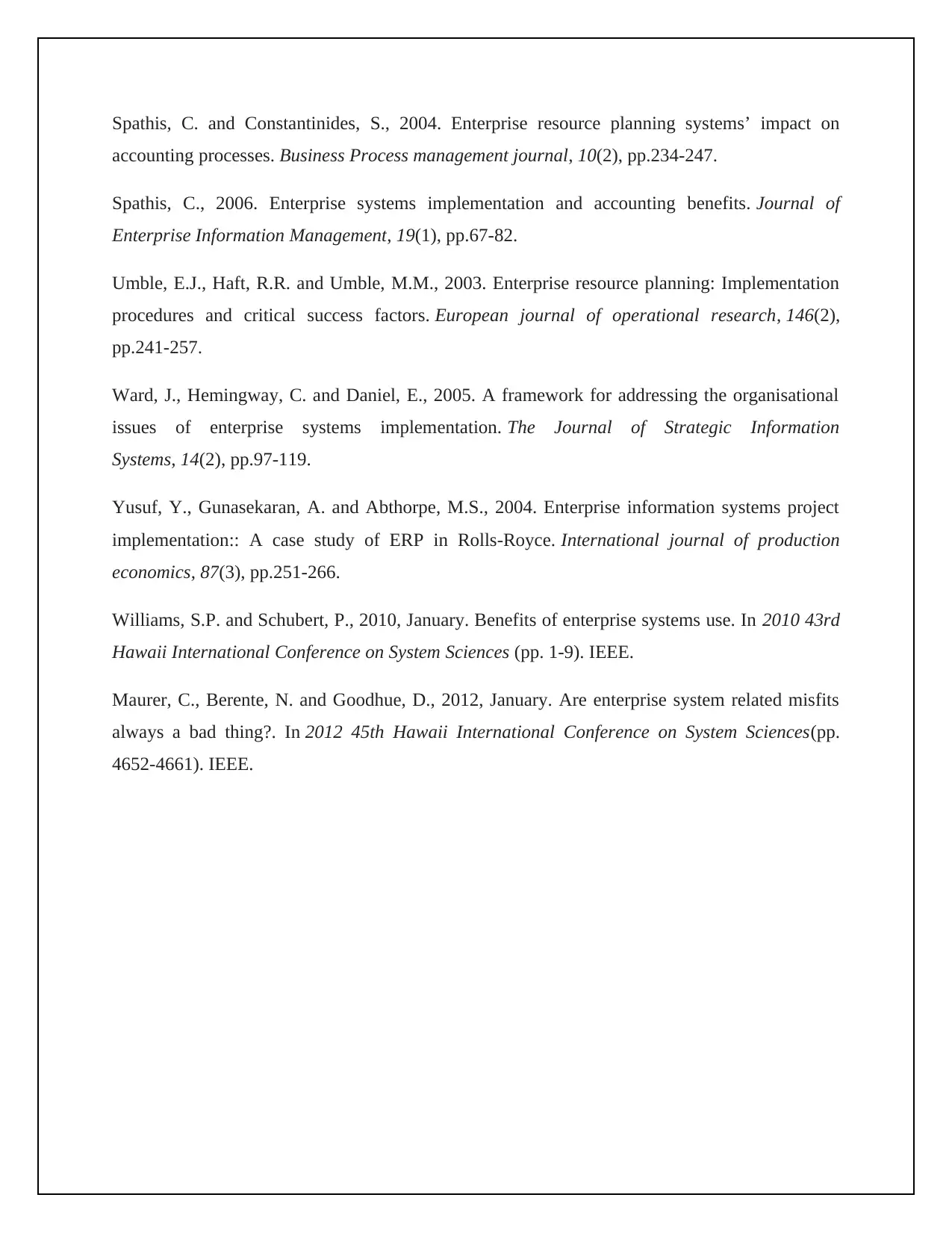
Spathis, C. and Constantinides, S., 2004. Enterprise resource planning systems’ impact on
accounting processes. Business Process management journal, 10(2), pp.234-247.
Spathis, C., 2006. Enterprise systems implementation and accounting benefits. Journal of
Enterprise Information Management, 19(1), pp.67-82.
Umble, E.J., Haft, R.R. and Umble, M.M., 2003. Enterprise resource planning: Implementation
procedures and critical success factors. European journal of operational research, 146(2),
pp.241-257.
Ward, J., Hemingway, C. and Daniel, E., 2005. A framework for addressing the organisational
issues of enterprise systems implementation. The Journal of Strategic Information
Systems, 14(2), pp.97-119.
Yusuf, Y., Gunasekaran, A. and Abthorpe, M.S., 2004. Enterprise information systems project
implementation:: A case study of ERP in Rolls-Royce. International journal of production
economics, 87(3), pp.251-266.
Williams, S.P. and Schubert, P., 2010, January. Benefits of enterprise systems use. In 2010 43rd
Hawaii International Conference on System Sciences (pp. 1-9). IEEE.
Maurer, C., Berente, N. and Goodhue, D., 2012, January. Are enterprise system related misfits
always a bad thing?. In 2012 45th Hawaii International Conference on System Sciences(pp.
4652-4661). IEEE.
accounting processes. Business Process management journal, 10(2), pp.234-247.
Spathis, C., 2006. Enterprise systems implementation and accounting benefits. Journal of
Enterprise Information Management, 19(1), pp.67-82.
Umble, E.J., Haft, R.R. and Umble, M.M., 2003. Enterprise resource planning: Implementation
procedures and critical success factors. European journal of operational research, 146(2),
pp.241-257.
Ward, J., Hemingway, C. and Daniel, E., 2005. A framework for addressing the organisational
issues of enterprise systems implementation. The Journal of Strategic Information
Systems, 14(2), pp.97-119.
Yusuf, Y., Gunasekaran, A. and Abthorpe, M.S., 2004. Enterprise information systems project
implementation:: A case study of ERP in Rolls-Royce. International journal of production
economics, 87(3), pp.251-266.
Williams, S.P. and Schubert, P., 2010, January. Benefits of enterprise systems use. In 2010 43rd
Hawaii International Conference on System Sciences (pp. 1-9). IEEE.
Maurer, C., Berente, N. and Goodhue, D., 2012, January. Are enterprise system related misfits
always a bad thing?. In 2012 45th Hawaii International Conference on System Sciences(pp.
4652-4661). IEEE.
⊘ This is a preview!⊘
Do you want full access?
Subscribe today to unlock all pages.

Trusted by 1+ million students worldwide
1 out of 12
Related Documents
Your All-in-One AI-Powered Toolkit for Academic Success.
+13062052269
info@desklib.com
Available 24*7 on WhatsApp / Email
![[object Object]](/_next/static/media/star-bottom.7253800d.svg)
Unlock your academic potential
Copyright © 2020–2025 A2Z Services. All Rights Reserved. Developed and managed by ZUCOL.





